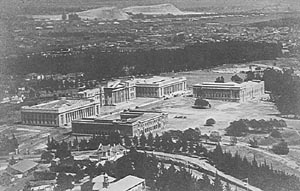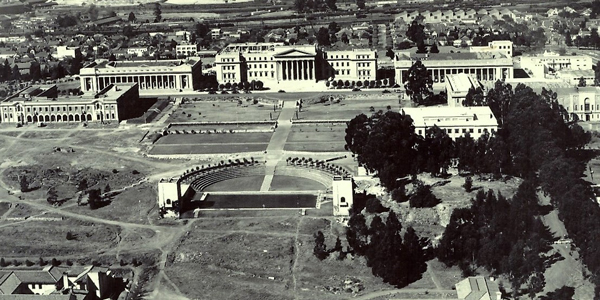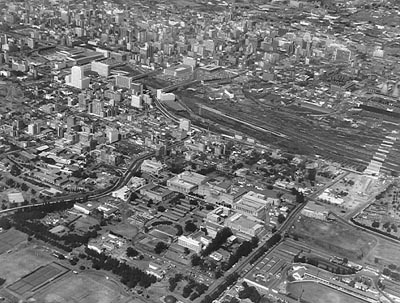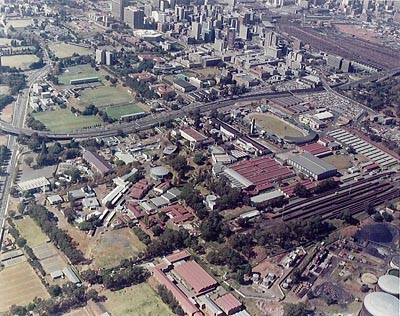Our History
From humble beginnings as a School of Mines to a University ranked in the top 1% in the world, Wits has shaped South Africa through its academic and research excellence, and political and civic activism.
From humble beginnings as a School of Mines to a University ranked in the top 1% in the world, Wits has shaped South Africa through its academic and research excellence, and political and civic activism.
The origins of Wits University lie in the South African School of Mines, which was established in Kimberley in 1896 and transferred to Johannesburg as the Transvaal Technical Institute in 1904, becoming the Transvaal University College in 1906 and renamed the South African School of Mines and Technology four years later. Other departments were added as Johannesburg grew and in 1920 the name was changed to the University College, Johannesburg.
Full university status was granted in 1922, incorporating the College as the University of the Witwatersrand, with effect 1 March. Seven months later the inauguration of the University was duly celebrated. Prince Arthur of Connaught, Governor-General of the Union of South Africa, became the University's first Chancellor, and Professor Jan H. Hofmeyr its first Principal. Building began at Milner Park on a site donated to the University by the Johannesburg municipality.

In 1923, the University gradually vacated its premises in Eloff Street to move to the first completed teaching buildings at Milner Park (the Botany and Zoology block - housing the departments of Geology, Botany, Zoology and Applied Mathematics). The University had, at that stage, 6 faculties (Arts, Science, Medicine, Engineering, Law and Commerce), 37 departments, 73 members of academic staff and little more than 1 000 students. In 1925 the Prince of Wales officially opened the Central Block.
During the period between the two world wars severe financial restrictions were imposed upon the University. Nevertheless, student numbers were quite impressive - in 1939, 2 544 students enrolled; that grew to 3 100 in 1945. The sudden increase in student enrolment after the Second World War led to accommodation problems, which were temporarily resolved by the construction of wood and galvanised-iron hutments in the centre of the campus. These huts remained in use until 1972.

The period between 1947 and the 1980s was marked by considerable growth - student numbers increased rapidly to 6 275 in 1963, 10 600 in 1975 and 16 400 by 1985. In 1951 the University awarded its 10 433rd qualification, in May 1981 its 50 000th and by 1988 its 73 411th.
The acquisition of additional property in adjacent areas became imperative. The medical library and the administrative offices of the Faculty of Medicine moved to a new building in Esselen Street, Hillbrow during 1964. The Graduate School of Business was established in Parktown in 1968. In 1969 the Ernest Oppenheimer Residence was formally opened in Parktown. Savernake, the official residence of the Vice-Chancellor, also located in Parktown, was made available to the University in 1969. In the same year the clinical departments in the new Medical School were opened. However, the Medical School moved premises again and is now situated in York Road, Parktown - the complex was opened on 30 August 1982.
Expansion into Braamfontein also took place. In 1976 Lawson's Corner, renamed University Corner, was acquired. Senate House, the University's main administrative building, was occupied in 1977. The Wedge, a building formerly owned by the National Institute of Metallurgy, was taken over by the University in 1979. The Milner Park showgrounds were acquired in 1984 from the Witwatersrand Agricultural Society and renamed West Campus. Today, the campuses are some 400 hectares in extent. In 1989, the Chamber of Mines Building for the Faculty of Engineering on the West Campus was opened, and the brick-paved AMIC deck was built across the M1 motorway to link the East and West campuses.
The University's interests have not been confined to development and expansion at Milner Park and adjacent areas. In the 1960s the University acquired the Sterkfontein farm from the Stegmann family, with its world-famous limestone caves, rich in archaeological material. In 1968 the neighbouring farm, Swartkrans, also a source of archaeological material, was purchased. In the same year, the University acquired excavation rights in caves of archaeological and palaeontological importance at Makapansgat in the area now known as the Limpopo Province.

From the onset, Wits was founded as an open university with a policy of non-discrimination - on racial or any other grounds. This commitment faced its ultimate test when the apartheid-government passed the Extension of the University Education Act in 1959, thereby enforcing university apartheid.
The Wits community protested strongly and continued to maintain a firm, consistent and vigorous stand against apartheid, not only in education, but in all its manifestations. These protests were sustained as more and more civil liberties were withdrawn and peaceful opposition to apartheid was suppressed. The consequences for the University were severe - banning, deportation and detention of staff and students, as well as invasions of the campus by riot police to disrupt peaceful protest meetings.
With the dismantling of apartheid and the election of a democratic government, the role of Wits as a resource became increasingly important. Wits University served as a hub for critical thinking, debates and engagement during the transition from apartheid to democracy. Academics were involved in the drafting of the Constitution of South Africa and the first two chief justices of democratic South Africa were Wits graduates.

Over the years, the University of the Witwatersrand became internationally recognised for its academic excellence and extensive research activities. During the Second World War members of the University staff took an active part in the original development and construction of radar. Wits was the first South African university to have a nuclear accelerator, to have a computer, to study building materials and early Afrikaans, to produce a systematic climatological atlas of southern Africa and to achieve a successful graft of plastic cornea.
The country's first dental hospital and school was established by the University. It was also a local first in the field of physio- and occupational therapy and the first South African institution to open a clinic for the treatment of speech defects.
The first blood transfusion service in the Union of South Africa was started by Wits medical students and the Medical School undertook the first clinical survey of childbirth in African tribal conditions. The University's scholars have also greatly advanced the theory of human origin and evolution. There are many more such examples.
Today, with five faculties (Commerce, Law and Management; Engineering and the Built Environment; Health Sciences; Humanities and Science) and 33 schools, Wits offers over 3 000 courses to about 40 000 students.
Almost 40% of the student body comprises of postgraduate students. Wits is home to 11 libraries with students having access to over 1.5 million books and journals. Just over 6 000 students are accommodated in 17 residences and student villages. There are over 30 sports clubs and societies in which students can participate.
Visitors, staff and students can also explore Wits’ seven museums, the Wits Sterkfontein Caves, the Wits Theatre Complex, the Wits Anglo American Digital Dome, and the Wits Chris Seabrooke Music Hall, which was opened in 2022 as part of the Centenary Celebrations.
Wits University celebrated 100 years of excellence in 2022. Celebrations took place throughout the year, and saw the opening of new buildings like the Chris Seabrooke Music Hall and the launch of the Wits Anglo American Digital Dome, the Wits Brain and Dorothy Zylstra Complex, and other projects.
Alumni reunions were held in the US, UK, Australia and South Africa. Witsies made it to Times Square in New York and also celebrated the Homecoming Weekend, a light show, a performance by William Kentridge at the Linder Auditorium, a concert, a parade, and other activities.
Senate House renamed Solomon Mahlangu House
The renaming of Senate House took place in the wake of the #FeesMustFall protests and was done in commemoration of struggle stalwart Solomon Mahlangu.
The renaming of Central Block to Robert Sobukwe Block (the building that houses the Wits Great Hall), acknowledged Robert Sobukwe’s service to the University and his contribution to fighting apartheid. Sobukwe, an intellectual, founder and first president of the Pan African Congress, was celebrated for his role in initiating and leading the anti-pass law protests of 21 March 1960.
The Mathematical Sciences building was renamed after Dr Thamsanqa Wilkinson Kambule in 2017. Dr Kambule was an inspirational teacher and leader who fought for high-quality education for Black people in apartheid South Africa. He joined Wits in 1978 as a Senior Tutor in the then Department of Mathematics, serving as a role-model for about a decade. He was elected to the Council of the University in 1989 and awarded an honorary doctorate from Wits in 1997. In 2002, Dr Kambule received the Order of the Baobab in Gold for his exceptional contribution to mathematics education, human development and community service. It is hoped that by naming the building after a leading African mathematician, it will inspire future generations of mathematical scientists to excel in the discipline.
The Chamber of Mines Building on the Braamfontein West Campus was renamed the African Rainbow Minerals Building, following a partnership between ARM and Wits University. This building was originally opened in 1989, with the fourth quadrant completed in 2012. It houses the Faculty of Engineering and the Built Environment’s administration, the School of Mining Engineering and the School of Electrical and Information Engineering. The building is also home to the multidisciplinary Wits Mining Institute, a DigiMine and two other research entities.
University Corner was renamed after the renowned writer and activist Es'kia Mphahlele as part of Wits’ continuing transformation plan. The renaming of the popular building which houses the Wits Centre for Journalism, the Wits Centre for Diversity Studies and the Wits Art Museum to name a few, is a fitting tribute to Mphahlele, the first black Full Professor at Wits.
Wits University and Sibanye-Stillwater unveiled the refurbished and rebranded Wits Sibanye-Stillwater Innovation Bridge, a Wits Centenary Project, on 12 July 2023. It was accompanied by an additional commitment of R51 million from Sibanye-Stillwater to Wits for study bursaries, learnership within the Group’s mining operations, graduate internship programmes and staff development within the Wits Faculty of Engineering and the Built Environment.
The former Planetarium, now the Wits Anglo American Digital Dome was recognised for its academic and cultural heritage by the Johannesburg Heritage Foundation and the City of Johannesburg which unveiled a historic Blue Plaque in 2025.
Engineering students gather early in the morning on the first day of September each year and prepare breakfast to celebrate the arrival of spring. While they are meant to wear pyjamas, many students nowadays just dress outrageously.
Not condoned by the University, this risqué tradition of Knockando Residence students running naked through Parktown to visit the women’s residences after imbibing ‘Courage Juice’ has endured for decades.
Spring in Jozi brings with it the blossoming of the beautiful Jacaranda flowers. Witsies believe that if one of the purple flowers falls on your head and you have not started studying for your year-end exams, then it is probably too late and you are doomed to fail.
Mining Engineering students don their underground mining gear for Skiffyskofbaas Day in July each year and traipse around campus in a mining-related rendition of ‘trick or treat’. ‘Skiffy’ translates loosely to menial worker (‘skivvy’), while ‘skofbaas’ refers to a shift boss. After the festivities the students down a pint at Ore House on the West Campus. Nowadays Skiffyskofbaas Day is known as the more politically correct ‘Miners’ Day’.
In what originated as a fundraiser to beat a Guinness World Record for the number of participants in a pillow fight, Witsies now gather on the Library Lawns in September, armed with pillows to pummel each other in a riotous explosion of feathers, fabric and foam.
The Mr and Miss Wits beauty pageant used to take place annually in the Wits Great Hall with a panel of celebrity judges. During their reign, Mr and Miss Wits were required to do charity work and to encourage students to do the same.
For many decades, Wits students held an annual Rag (Remember and Give) Parade after an intensive six-week charity fundraising campaign. After many festive nights spent decorating their floats, students would take to the streets of Johannesburg in their finest fancy dress, parading through town and showing off their fabulous floats in an attempt to win the award for best float. In the run-up to the parade, students would hit the streets selling copies of the Wits Rag magazine, in a campaign commonly known as the “Wits Blitz”. Each year, a Rag Queen was elected and after the parade, a Rag Ball was held in the Examinations Hall. The Ball was always an elegant affair where only evening gowns and dinner suits were considered appropriate attire.
Graduation Ball was a festive and formal annual event organised by students. The Ball, usually held at the Wanderers Hall, saw a host of high-profile guests mingle with recent graduates dressed in their finest attire, in the hope of being mentioned in the local newspaper. The Hall was decorated in Wits blue and gold, and dinner, drinks and dancing to a live band were the order of the day. The SRC election results were traditionally announced at the Ball.
Wits University was known for its Premier League football team, Bidvest Wits FC or the “Clever Boys”. Today, the Wits Football Club remains one of the largest clubs in the country. Witsies continue to excel in multiple sports, and even at the Olympics.
Back in the day, rugby was the most popular game on campus and the Inter-Varsity tournament against the University of Pretoria (“Tukkies”) was the highlight of the sporting calendar. For weeks prior to the match, students would gear up for the game with sing-songs to boost morale and student support. New students would learn the varsity song, led by cheerleaders.
There were also clandestine raids between the two universities, mainly involving students living in residence. The raids were a fun way to rile the opposition ahead of an important match. In 1956, a Wits University raid resulted in Tukkies’ administration buildings being painted red. The controversy generated by such events resulted in the raids being banned in the 1950s. Though students continued the raids illicitly, they eventually stopped in the 1960s when a student was killed in a car-chase. Today, the derby continues with the University of Johannesburg down the road.
The original Phineas was the Highlander Mascot of University College, London. His name-sake Phineas II, was a seven-foot wooden replica used to promote a barber shop in Jules street, Johannesburg. Phineas II was loaned to Wits serve as its mascot in 1923. However, UCT abducted Phineas that year. Phineas III proved to be as slippery as his predecessors and fell into the hands of the University of Pretoria in 1930. This marked the beginning of raids between the two universities. Phineas III retired from active service in 1971.
Visit the Alumni website for more information about our traditions
